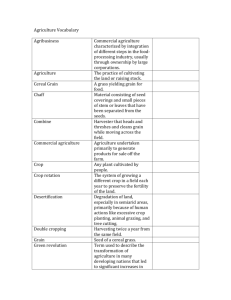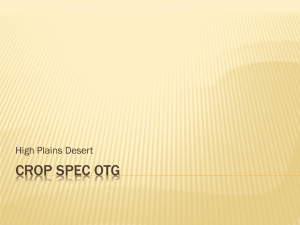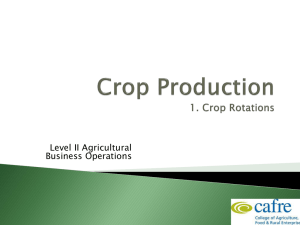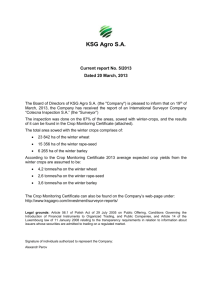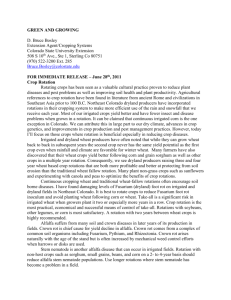crop rotation and residue durability effects of spring crops on winter
advertisement
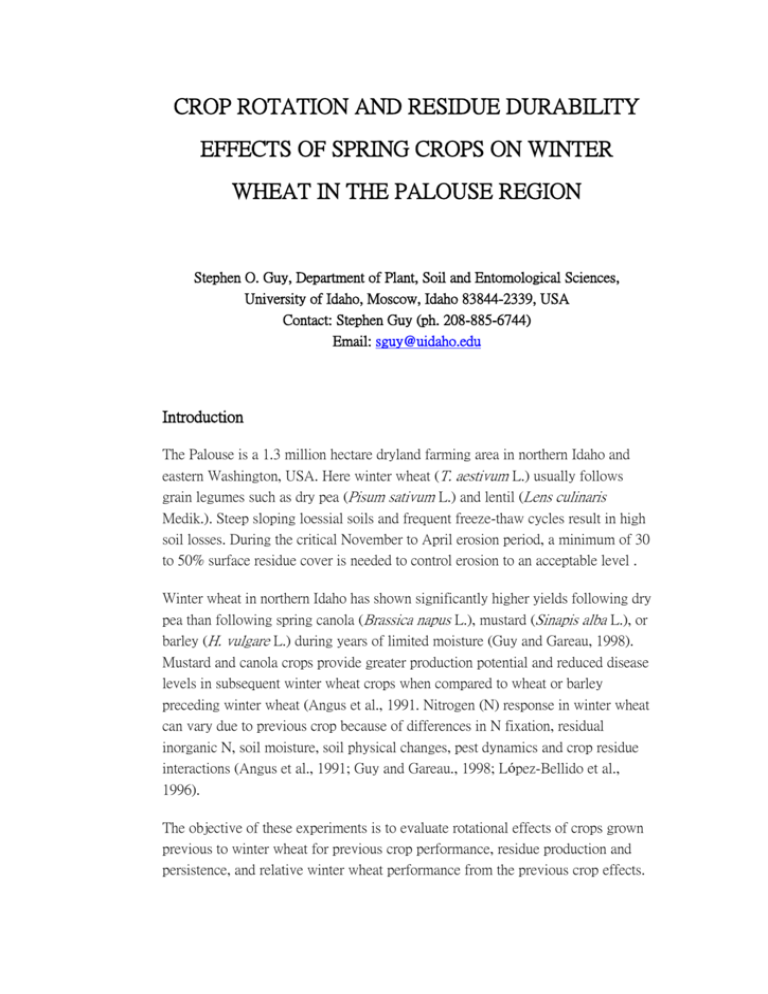
CROP ROTATION AND RESIDUE DURABILITY EFFECTS OF SPRING CROPS ON WINTER WHEAT IN THE PALOUSE REGION Stephen O. Guy, Department of Plant, Soil and Entomological Sciences, University of Idaho, Moscow, Idaho 83844-2339, USA Contact: Stephen Guy (ph. 208-885-6744) Email: sguy@uidaho.edu Introduction The Palouse is a 1.3 million hectare dryland farming area in northern Idaho and eastern Washington, USA. Here winter wheat (T. aestivum L.) usually follows grain legumes such as dry pea (Pisum sativum L.) and lentil (Lens culinaris Medik.). Steep sloping loessial soils and frequent freeze-thaw cycles result in high soil losses. During the critical November to April erosion period, a minimum of 30 to 50% surface residue cover is needed to control erosion to an acceptable level . Winter wheat in northern Idaho has shown significantly higher yields following dry pea than following spring canola (Brassica napus L.), mustard (Sinapis alba L.), or barley (H. vulgare L.) during years of limited moisture (Guy and Gareau, 1998). Mustard and canola crops provide greater production potential and reduced disease levels in subsequent winter wheat crops when compared to wheat or barley preceding winter wheat (Angus et al., 1991. Nitrogen (N) response in winter wheat can vary due to previous crop because of differences in N fixation, residual inorganic N, soil moisture, soil physical changes, pest dynamics and crop residue interactions (Angus et al., 1991; Guy and Gareau., 1998; López-Bellido et al., 1996). The objective of these experiments is to evaluate rotational effects of crops grown previous to winter wheat for previous crop performance, residue production and persistence, and relative winter wheat performance from the previous crop effects. Materials and Methods Condiment mustard, dry pea, and lentil were planted in April of 1994 and 1995 in a randomized complete block design with four replications in a Palouse silt loam soil near Moscow, Idaho, USA. Individual plots were 7.6 m by 152 m in 1994 and 4.9 m by 183 m in 1995. The harvest combine was equipped with a chaff spreader to distribute residue onto each plot area. Crop residues were collected from three areas in each plot inside a template area of 0.75 m2 placed across the crop rows. Residual inorganic N was determined to 0.9 m soil depth before winter wheat planting. Seedbed preparation for the subsequent winter wheat crops (Crop Year 2 of each 2-year cycle) was done using conventional tillage and seeding operations. A line-point method was applied to determine percent residue surface cover along a 15 m tape-line. Monthly residue evaluations were taken when conditions allowed from October through April. A 15 m end section in each plot area was divided into sub-plots to establish N fertilizer trials at rates of 0, 45, 90, 135, 180, and 225 kg N ha-1 using the previous spring crop as the main plots, and N rates as sub-plots. The remaining large plot areas were top-dressed with 80 kg ha-1 of N fertilizer. All areas received 49 kg N ha-2, 27 kg P2O5 ha-2, and 18 kg SO4 ha-2 incorporated prior to winter wheat seeding. In small plot rotation trials (9.1 m by 7.6 m), winter wheat, spring wheat, spring barley, spring canola, mustard, crambe (Crambe abssinica Hochst.), winter rape (B. napus L.), and dry pea were grown from 1991 to 1995 prior to a winter wheat crop. Winter wheat was uniformly cropped across the previous crop areas before dividing into sub-plots for variable N fertilizer application evaluation. The previous crop influences were assessed for the following winter wheat crop agronomic performance and N fertilizer response. Yield responses across years for previous crop effects on winter wheat were compared as a percent of the yield of wheat yield following pea. Results and Discussion Spring crop performance and residue evaluation Seed yields were different among the three spring crops in the large plot trials (Table 1). The pea and lentil seed yields were above average for the region. Mustard seed yields were slightly lower than expected due to lack of moisture from May through July in 1994 and due to establishment and weed problems in 1995. Soil N nitrate and ammonia assessed to 0.9 m soil depth after harvest was not different among the spring crops. Table 1. Seed yield, residue production and after-seeding residue surface cover persistence of three spring crops grown during 1994 and 1995 and winter wheat yield following the spring crops near Moscow, Idaho, USA Crop Yield Overwinter Residue Residual Winter Spring Crop Seed Residue Soil N Oct Dec Feb Mar Wheat Yield kg ha-1 % Surface Cover kg ha-1 Mustard 1230 6300 48 58 59 62 61 7100 Pea 3460 3470 49 33 31 30 28 7500 Lentil 2420 4170 39 28 28 26 26 7600 Average 2370 4650 46 40 38 36 35 7400 ns 10 6 7 3 ns LSD (0.05) 480 920 Despite the lower seed yield, the residue produced by mustard was significantly higher than pea or lentil (Table 1). Total biomass (seed + residue) averaged 7530 kg ha-1 for mustard, 6930 kg ha-1 for pea and 6590 kg ha-1 for lentil. This benefit of high residue production and potential erosion reduction contributes to the value of mustard as a crop and is an advantage over dry pea or lentil. Harvest index (seed/(seed + residue) x 100), was significantly different among the three spring crops, 50% for pea, 37% for lentil, and 16% for mustard. Residue surface cover was 100% for mustard, 88% for lentil, and 84% for pea after harvest. Residue surface cover was reduced during seedbed preparation and planting of winter wheat to 58% for mustard, 33% for pea, and 28% for lentil (Table 1). Residues from all three crops were more durable over the winter than expected, showing little change in surface cover until March. The seedbed preparations and planting of the winter wheat in 1994 were done in dry conditions and little rain fell until late October, slowing the residue decomposition rate. When residue surface cover started to decrease, winter wheat and weed growth after March more than compensated for the decline in crop residue. Residue cover measured on the mustard plots was consistently above the 30 to 50% target level set by USDA conservation plans for erosion control. Pea residue over-winter surface cover was just below this target level after December, while lentil residue was below the target level at all times after seedbed preparation and planting of the winter wheat. This shows the difficulty in providing adequate surface groundcover following legume crops. Also, lentil residue is incorporated or lost from the surface to a greater extent than pea residue from tillage used in these experiments. This probably is due to the smaller size and greater fragility of the lentil residue. Effect of previous crop on winter wheat performance In the 1994-95 trial, winter wheat yields were significantly higher following pea and lentil than following mustard. In the 1995-96 trial, however, wheat yield was not significantly different among previous crop treatments. Averaged over both trials, wheat yields were not different among previous crop treatments (Table 1). Winter wheat grain test weight differences were small, but were highest when wheat followed lentil. There were no significant differences due to previous crop for winter wheat grain protein content or seed weight. Winter wheat seed yield increased 60% as spring applied N rate increased from 0 to 180 kg ha-1. As shown by regression analysis, yield response to fertilizer N was not different among previous crops in regression line slope or position (R2 = 0.98 to 0.99). However, Linear plateau regression analysis of winter wheat yield response to fertilizer N (R2 = 0.97 to 0.99) revealed optimum fertilizer rates of 135 kg ha-1 following pea or lentil, and 180 kg ha-1 following mustard. This plateau was at a wheat yield of 9400 kg ha-1 following pea and mustard, and 9200 kg ha-1 following lentil. Winter wheat yield following eight crops Results pooled from five crop sequence trials show that winter wheat yield following pea and spring Brassica crops were highest (Figure 1). These trials did not include results from 1994 trials when a dry growing season allowed wheat yield response to residual soil moisture after pea that gave a 20 to 30% yield advantage for winter wheat following pea. Results from other years do not show this advantage to pea over mustard, canola, and crambe as previous crops to wheat. Winter rape did not appear to be as beneficial of a previous crop as spring canola, mustard, or crambe. Wheat yields were at least 25% less following wheat than after canola, mustard, crambe, or pea. These crop sequence trials show that the more different a crop is previous to winter wheat, e.g. spring broadleaf, the greater the rotation advantage. Rotation of broadleaf crops with grass crops appears to be more important than rotating spring and fall crops when weed control is not a factor. In some experiments it appears there was also a rotational advantage to previous crops that do not use all the soil moisture when the following crop season available moisture is limiting to wheat production. Figure 1. Winter Wheat Yields Following Previous Crops as a Percent of Yield following Pea from Four Experiments near Moscow, Idaho, USA Conclusions Mustard, canola, crambe, pea and lentil are excellent rotation crops prior to winter wheat. Additionally, some years pea and lentil can provide some carryover soil moisture for dry growing conditions and fix nitrogen. Brassica crops such as mustard, canola, and crambe are excellent rotation crops and provide large amounts of crop residue that is important for erosion control. Grain legumes must be better managed for residue production and retention for soil erosion control. These broadleaf crops are important for sustainable crop production systems on the Palouse and will continue to be grown in rotation with winter wheat. References Angus, J., Van Herwaarden A., and Howe G. 1991. Productivity and break crop effects of winter growing oilseeds. Australian Journal Experimental Agriculture 31:669-677 Guy S. and R. Gareau. 1998. Crop rotation, residue durability, and nitrogen fertilizer effects on winter wheat production. Journal of Production Agriculture 11:457-461 López-Bellido L., Fuentes M., Castillo J., López-Garrido F. and Fernández E. 1996. Long-term tillage, crop rotation, and nitrogen fertilizer effects on wheat yield under rainfed Mediterranean conditions. Agronomy Journal 88:783-791



